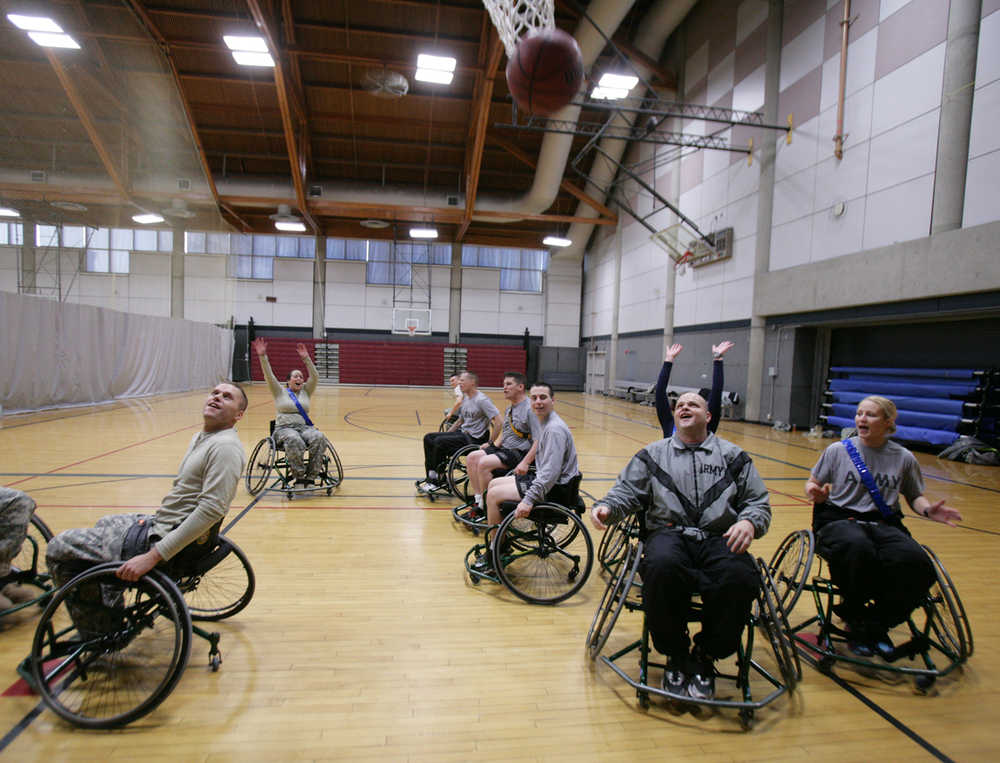FAIRBANKS (AP) — The Warrior Transition Unit at Fort Wainwright invited families, friends and community members to the post’s Physical Fitness Center to commemorate national Warrior Care Month.
Soldiers from the transition unit, and the occasional visitor, participated Nov. 3 in adaptive sports such as wheelchair basketball and sit-down volleyball from 1-3 p.m. The idea, according to Bassett Army Community Hospital public affairs coordinator Brandy Ostanik, is to recognize not only the effort put in each day by the soldiers in the unit but also the staff members who work with them and the families who support them.
The Warrior Transition Unit — or the WTU as the acronym-loving United States Army refers to it — is a small unit of soldiers on Post working through the long process of recovery.
To be assigned to the unit, soldiers must be reviewed and approved by the post’s high-ranking medical chiefs, such as the Medical Treatment Facilities commander. The conditions for entry to the unit vary depending on a number of factors but essentially, soldiers’ conditions must require what Army medical professionals consider “complex medical care” expected to take at least six months.
Warrior Transition Units were created Army-wide in 2007-08, and the For Wainwright unit came into existence in 2009, according to the unit’s current commander, Capt. John Harvey.
The 16 soldiers that make up Harvey’s unit are all serving on active duty, but none are assigned the typical duties of active duty military members. Instead, the soldiers of the transition unit focus on two things — getting better and preparing for what comes next.
For many of the soldiers, that “what’s next” will not take place in the Army. For many of them, the Warrior Transition Unit will serve as their last tour with the Army before fully transitioning to life as veterans.
Sgt. Matt Williams is one of those soldiers. In addition to his individual appointments and work with the unit, he spends much of his time learning automotive repair at the Fort Wainwright Automotive Skills Center and studying welding at the University of Alaska Fairbanks. The career training courses are coordinated with his unit.
Williams has been with the transition unit for six months, and has perhaps four or five months remaining on active duty. When his time with the unit is up he will not be returning to his former unit. Instead, his 10 years with the Army will come to an end.
Williams, like many soldiers in Wainwright’s transition unit and others around the country, displays no overt signs of physical trauma. Ostanik said as the number of soldiers in combat deployments falls, the number of soldiers in transition units with complex physical ailments have begun to more and more to be replaced with soldiers suffering from behavioral health issues.
He expressed frustration with the Army over his situation. He feels as if he is being forced out of the Army, but he has taken his acceptance to the transition unit gladly over the alternatives. With the transition unit, he said, he has no full-time job except to work toward his two transition goals.
“I get a lot more family time,” he said. “I can actually focus on my transition instead of doing a job at the same time.”
Harvey, who has led the transition unit at Wainwright for the last 18 months, said that’s exactly the intent of the program: to “help them find what they want to do and go do it.” So that when the time comes and their military service ends, the soldiers of the Warrior Transition Unit are able to leave without feeling completely left behind.

